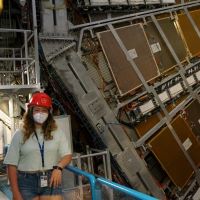Eleanor Jones
Eleanor is a PhD student in the Elementary and Particle Physics group
"I graduated Durham University in June 2018 with an MSci in Maths and Physics and I started my PhD at Warwick in October. I work as part of the ATLAS group within the Elementary Particle Physics group. My research focuses mainly on the Higgs sector and searching for a specific decay of the Higgs to a bottom quark-antiquark pair. I have also been involved with teaching whilst at Warwick, through maths support classes and demonstrating the first year electronics workshops."
How did your journey into Physics begin?
I always enjoyed science and maths at school and my parents also encouraged me to be curious and investigate the world. We would make little experiments in the house to understand how things worked, things like making pulleys and unwiring a plug or other electronics. It wasn’t really until I was 18 though that I decided to follow a physics path in someway. At this point though, I still had no idea where I would end up; I had just decided that I wanted to do natural sciences at university because I liked science and could continue with physics, maths and chemistry. Now that I’m doing a PhD in particle physics, I’m just really happy about how my choices have played out and that I have ended up doing something I love.
What is your favour thing about your research area?
For me, I think it’s the fact that I am continually learning new things and that there is so much left to learn and understand as well. I study particle physics and one of the most amazing facts to me is that the knowledge we have about the universe accounts for about 4% of what’s in the universe. We still don’t know what dark matter and dark energy is and there are still so many other open questions within physics, which makes it so puzzling and exciting!
Why do you think it is important to highlight women and gender minorities in science? Why is it important to you?
The benefits of having a diverse workplace have been well documented but it is also clear that there is still a long way to go to achieve the diversity. The gender gap in STEM subjects is still massive and, as a result, a lot of young people don’t even have a vision of what a woman in science looks like. This often perpetuates the mindset that women just don’t do science. It is so important that we try to smash these stereotypes and highlighting women in science day is a fantastic way of doing this. Showcasing the variety of jobs available and the women that fill these roles will hopefully give young girls who are just starting to decide their paths role models and they will see that that there is so much available to them.

